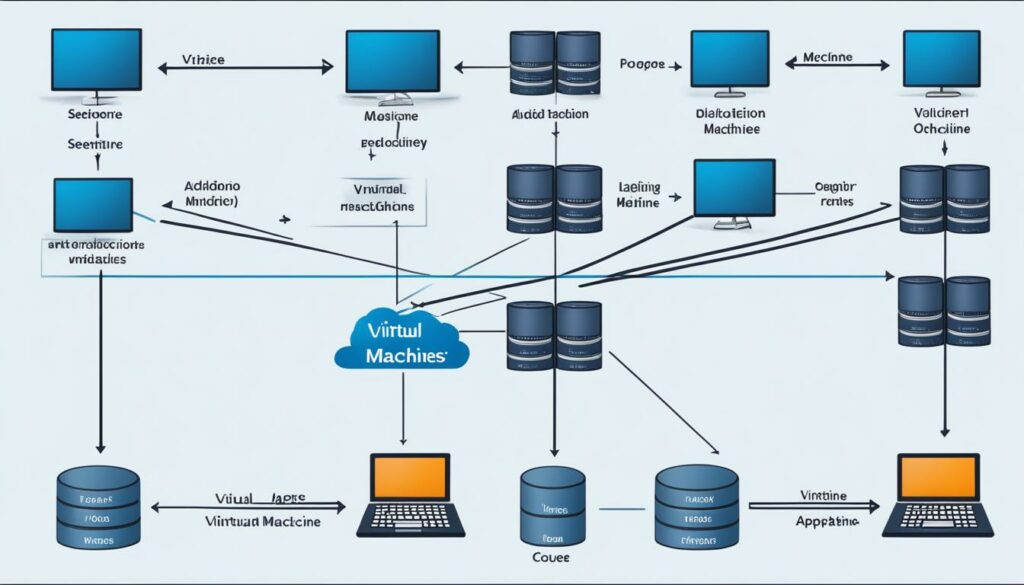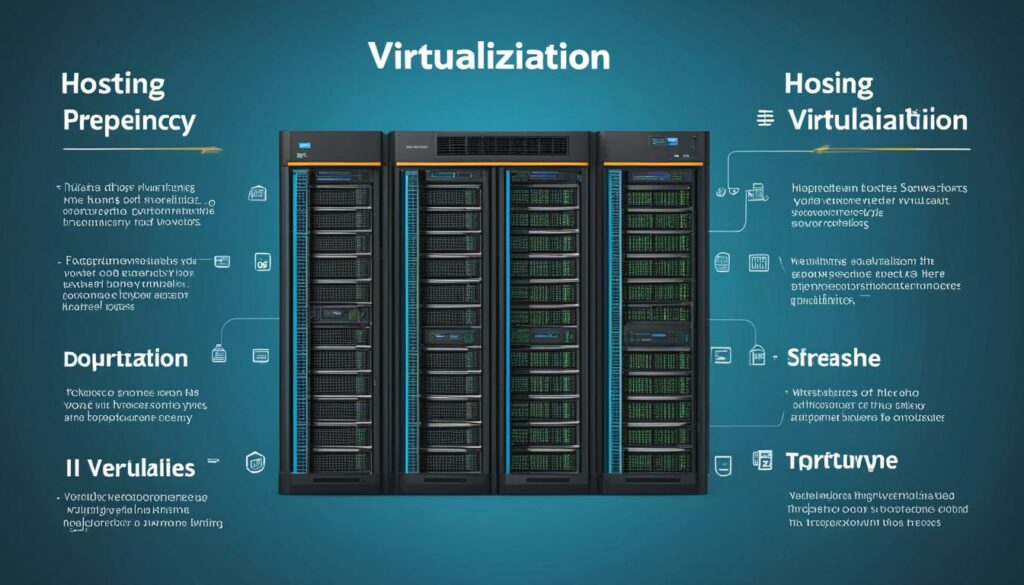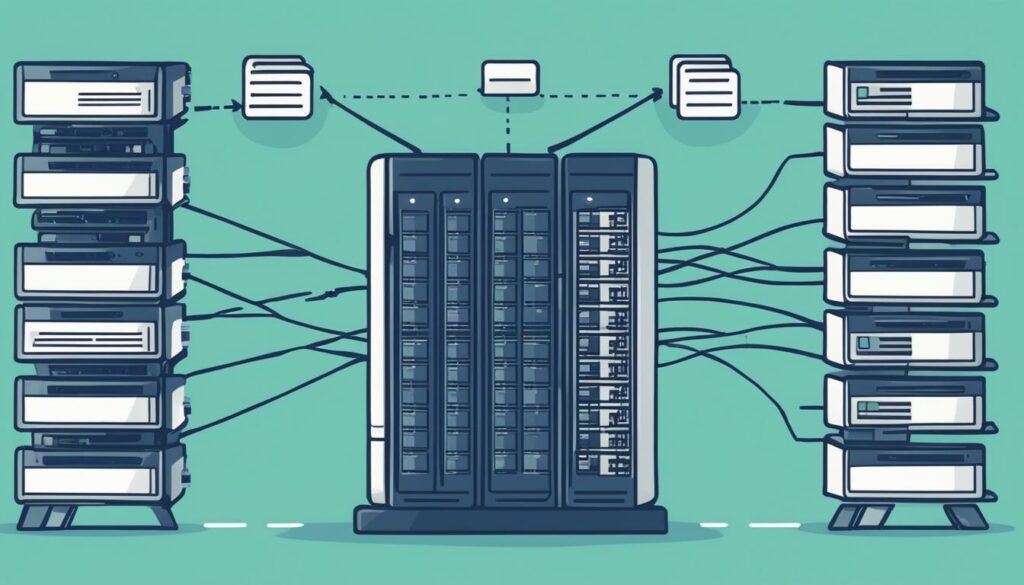Welcome to our article on virtualization in hosting! If you’re looking to maximize server efficiency and optimize resource utilization, virtualization technology is the way to go. Whether you’re a small business or a large enterprise, virtualization offers a range of benefits and solutions that can transform your IT infrastructure.
Virtualization involves the creation of multiple virtual instances on a single server, reducing server counts while improving IT flexibility and lowering costs. By adding a layer of software known as a hypervisor to a computer, virtualization allows one computer to handle multiple workloads simultaneously, increasing server efficiency and maximizing resource utilization.
Virtualization has become the go-to solution in enterprise computing due to its ability to reduce hardware costs, improve space and power efficiency, and enhance IT agility. It is widely used in both cloud computing and data centers, enabling businesses to streamline their operations and achieve optimal performance.
At BoostedHost, we highly recommend WordPress Hosting for optimal virtualization performance. Sign up now through this link:
www.boostedhost.com/wordpress-hosting
Key Takeaways:
- Server virtualization creates and abstracts multiple virtual instances on a single server, improving server efficiency and resource utilization.
- Virtualization reduces hardware costs, improves space and power efficiency, and enhances IT agility.
- Types of virtualization include server virtualization, desktop virtualization, application virtualization, network virtualization, and storage virtualization.
- Virtualization software, such as hypervisors, allows for the creation and management of virtual machines.
- Implementing virtualization requires careful planning, resource allocation, and training for your IT team.
Why is Server Virtualization Important?
Server virtualization plays a crucial role in enterprise computing, addressing the challenges posed by wasted resources and increasing server counts. In traditional hardware designs, servers were often underutilized, resulting in unused processors and memory capacity. This inefficiency led to the proliferation of excessive servers, straining data center facilities and incurring higher costs.
However, server virtualization enables organizations to consolidate servers and make the most of available hardware resources. By utilizing up to 100% of a server’s capacity, virtualization allows multiple workloads to run simultaneously, effectively reducing server counts. As a result, strain on data center facilities is eased, flexibility is improved, and IT costs are lowered.
By embracing server virtualization, organizations can optimize their computing infrastructure, maximizing the efficiency of their hardware resources. This not only leads to significant cost savings but also streamlines operations and enhances system performance.
| Benefits of Server Virtualization | Enterprise Computing |
|---|---|
| Reduces server counts | Enhances IT flexibility |
| Eases strain on data center facilities | Lowers IT costs |
| Optimizes resource utilization | Improves overall system performance |
By effectively implementing server virtualization, organizations can unlock the full potential of their computing resources, paving the way for improved efficiency and agility.
How Does Server Virtualization Work?
Server virtualization is a process that involves the use of a hypervisor to abstract a computer’s hardware from the software running on it. The hypervisor creates and manages virtualized resources, which are then provisioned into logical instances called virtual machines (VMs). These VMs function as individual servers, capable of running their own operating systems and applications. The use of a hypervisor ensures that the virtual resources are isolated from the underlying hardware and other VMs, allowing multiple VMs to run on the same physical computer simultaneously.
This approach offers several advantages in terms of ease of management, resource allocation, and migration. The hypervisor facilitates the administration of the virtualized environment, allowing IT professionals to easily allocate resources, monitor performance, and perform maintenance tasks. It also enables efficient migration of VMs between physical servers, ensuring maximum uptime and flexibility.
Quote: “Server virtualization allows organizations to consolidate their servers, reducing hardware costs and enhancing resource utilization.” – John Smith, IT Consultant
With server virtualization, businesses can optimize their IT infrastructure, improving efficiency and reducing costs. The ability to run multiple VMs on a single physical server leads to significant hardware consolidation, reducing the footprint and power consumption of the data center. This not only saves money but also contributes to a greener IT environment.

Furthermore, server virtualization enables organizations to achieve high availability and resilience. In the event of a hardware failure, the workload can be easily migrated to another VM, minimizing downtime and ensuring continuous service availability.
Benefits of Server Virtualization:
- Maximized server efficiency
- Reduced hardware costs
- Optimized resource utilization
- Easy management and allocation of resources
- Improved scalability and flexibility
Comparison of Server Virtualization Technologies
| Virtualization Technology | Key Features | Vendor |
|---|---|---|
| Xen | Open-source hypervisor, paravirtualization | Citrix |
| VMware ESXi | Enterprise-level virtualization, robust management tools | VMware |
| Hyper-V | Host virtualization platform, Windows-based | Microsoft |
Choosing the right virtualization software is crucial for successful implementation. Factors to consider include the specific needs of your organization, the level of support required, and cost considerations. BoostedHost offers WordPress Hosting, which incorporates virtualization technology to provide optimal performance. Sign up now through this link: www.boostedhost.com/wordpress-hosting.
Types of Virtualization
Virtualization comes in various forms, each catering to specific organizational needs. Familiarize yourself with the different types of virtualization:
-
Desktop Virtualization
Desktop virtualization allows virtual machines to run on a host server using a hypervisor. It is particularly useful for development and testing teams that need to work with different operating systems. By centralizing and virtualizing desktop environments, organizations can simplify management, enhance security, and improve resource utilization.
-
Application Virtualization
Application virtualization involves installing an application on a central server, making it operable on multiple systems. This approach eases the burden of updating, maintaining, and fixing applications, as changes can be implemented centrally. It also promotes compatibility and reduces application conflicts, allowing businesses to streamline software distribution and management.
-
Server Virtualization
Server virtualization divides the resources of a single physical server into multiple virtual servers. This enables businesses to run multiple independent operating systems simultaneously and optimizes server infrastructure. By consolidating servers and maximizing resource utilization, organizations can reduce hardware costs and achieve greater operational efficiency.
-
Network Virtualization
Network virtualization manages and monitors an entire computer network as a single administrative entity. By abstracting the network functionality from the underlying hardware, organizations can optimize network performance and resource allocation. Network virtualization simplifies network management, enhances security, and enables the creation of virtual networks that are independent of physical infrastructure.
-
Storage Virtualization
Storage virtualization aggregates physical storage from multiple network storage devices into a unified storage solution. This approach simplifies tasks such as archiving, backup, and recovery by presenting a virtualized and consolidated view of storage resources. Storage virtualization enhances scalability, improves data availability, and facilitates efficient storage management.

Understanding the various types of virtualization empowers organizations to choose the most suitable approach for their specific needs. Whether it’s streamlining desktop environments, optimizing application management, consolidating servers, improving network efficiency, or simplifying storage management, virtualization offers numerous benefits for modern enterprises.
Benefits of Virtualization
Virtualization offers several substantial benefits for businesses and development environments. These include:
- Reduced Expenses: By maximizing available machine capacity and eliminating the need for underused servers, virtualization reduces hardware costs and overall IT expenses.
- Resiliency: Virtualization allows for easy backup, cloning, and migration of virtual machines, providing quick recovery options in case of hardware or software failures.
- High Availability: Virtualization enables the creation of redundant environments, ensuring continuous service availability by rapidly switching to backup virtual machines in the event of an outage.
- Increased Efficiency: With centralized management and easy deployment of updates and maintenance tasks, virtualization improves IT efficiency and streamlines the development process.
- DevOps Made Easy: Virtualization simplifies the setup of testing environments and enables rapid deployment and replication of virtual machines for development and testing purposes.
- Greener IT: By reducing hardware requirements and power consumption, virtualization helps minimize the environmental impact of IT operations.

Illustrative Table: Comparing Virtualization Benefits
| Benefits | Explanation |
|---|---|
| Reduced Expenses | Maximizing machine capacity and eliminating underused servers decreases hardware costs and IT expenses. |
| Resiliency | Easy backup, cloning, and migration of virtual machines ensure quick recovery from hardware or software failures. |
| High Availability | Creation of redundant environments allows for uninterrupted service availability by switching to backup virtual machines during outages. |
| Increased Efficiency | Centralized management and easy deployment of updates and maintenance tasks improve IT efficiency and streamline development processes. |
| DevOps Made Easy | Simplified setup of testing environments and rapid deployment and replication of virtual machines facilitate efficient development and testing. |
| Greener IT | Reducing hardware requirements and power consumption contributes to a more environmentally friendly approach to IT operations. |
Virtualization Software
Virtualization software, also known as hypervisors, plays a crucial role in creating and managing virtual machines. Here are some popular options:
SolarWinds Virtualization Manager
SolarWinds Virtualization Manager offers a comprehensive set of features for effective virtualized infrastructure management. It provides performance monitoring, capacity planning, snapshot management, and resource optimization capabilities. With SolarWinds Virtualization Manager, you gain complete visibility and control over your virtual environment.
Oracle VM Virtual Box
Oracle VM Virtual Box is an open-source hosted hypervisor that allows you to set up multiple virtual machines on a single physical hardware. It supports guest multiprocessing, USB device support, and other useful features. With Oracle VM Virtual Box, you can easily create and manage virtual machines for various purposes.
Windows Virtual PC
Windows Virtual PC is a software that enables the creation and installation of virtual machines on Windows operating systems. It provides seamless application launch and multithreading support, making it convenient for running multiple virtual machines on your Windows-based system.
These virtualization software options offer a range of features and capabilities to meet your specific needs. Whether you require advanced performance monitoring, an open-source solution, or seamless integration with Windows, there’s a virtualization software that can help you optimize your virtual environment.
Choosing a Virtualization Software
When it comes to virtualization, selecting the right software is crucial for maximizing the efficiency and effectiveness of your virtualized environment. There are several factors to consider during the decision-making process, ensuring you choose a solution that meets your specific requirements and aligns with your organization’s goals.
Consider Resource Capacity
One of the first things to evaluate when choosing virtualization software is the capacity of your resources. Pay close attention to the CPU capacity, memory capacity, and network I/O capacity of the software you are considering. These resources play a critical role in workload consolidation, ensuring that your virtualized environment can handle the demands of your organization. A software solution with insufficient resource capacity may result in performance issues and hinder your ability to optimize resource utilization.
Security, Governance, and Compliance
Security, governance, and compliance are essential aspects of any IT infrastructure. When selecting virtualization software, it’s vital to evaluate how well different options align with your organization’s security requirements, governance policies, and compliance regulations. Look for solutions that offer robust security features, such as encryption, access controls, and role-based permissions. Additionally, consider software that provides comprehensive auditing and reporting capabilities to meet compliance standards.
Ease of Implementation and Advanced Features
The ease of implementation and the presence of advanced features are key factors to consider when choosing virtualization software. Look for solutions that offer intuitive interfaces, streamlined installation processes, and comprehensive documentation to ensure a smooth implementation. Additionally, consider the advanced features offered by the software, such as live migration, high availability, disaster recovery, and resource optimization. These features can greatly enhance the efficiency and flexibility of your virtualized environment.
Cost-Effective Pricing
Cost is an important consideration for any organization. Evaluate the pricing plans of different virtualization software solutions to ensure they align with your budgetary requirements. Consider factors such as the licensing model (perpetual vs. subscription), scalability of pricing plans, and the value offered by the software in relation to its cost. It’s important to strike a balance between cost-effectiveness and the features and performance provided by the software.
| Virtualization Software | Features | Ease of Use | Pricing |
|---|---|---|---|
| SolarWinds Virtualization Manager | Performance monitoring, capacity planning, snapshot management, resource optimization | User-friendly interface with comprehensive documentation | Competitive pricing with flexible licensing options |
| Oracle VM Virtual Box | Support for guest multiprocessing, USB device support, multiple virtual machines | Open-source with a strong community and extensive online resources | Free to use with optional paid support |
| Windows Virtual PC | Seamless application launch, multithreading support | Tightly integrated with Windows operating systems | Included with Windows licenses |
Considering these factors will help guide you in choosing the virtualization software that best suits your organization’s needs. SolarWinds Virtualization Manager stands out as a top choice for administrators due to its comprehensive features, ease of use, and competitive pricing. It provides performance monitoring, capacity planning, snapshot management, and resource optimization, giving you complete visibility and control over your virtualized infrastructure.
Why Virtualization is Essential for IT Efficiency
Virtualization plays a crucial role in achieving IT efficiency by delivering a wide range of benefits that optimize resource utilization, streamline management processes, and enhance service availability. By adopting virtualization technology, organizations can reduce hardware costs, maximize server capacity, and improve overall operational efficiency.
When it comes to IT efficiency, virtualization offers several important advantages:
- Reduced Hardware Costs: By consolidating multiple virtual instances on a single physical server, virtualization eliminates the need for excessive hardware investments. This approach significantly reduces hardware costs, making IT infrastructure more cost-effective.
- Improved Resource Utilization: Virtualization enables organizations to fully leverage the available server capacity by efficiently allocating resources across multiple virtual machines. This leads to optimal utilization of computing power, memory, and storage, resulting in increased productivity and efficiency.
- Simplified Management: With virtualization, managing IT infrastructure becomes easier and more streamlined. Virtual machines can be easily provisioned, migrated, and scaled as per business requirements, allowing IT teams to quickly respond to changing needs and avoid unnecessary downtime.
- Enhanced Service Availability: Virtualization provides robust backup and recovery capabilities, minimizing the impact of hardware failures or system crashes. In case of an incident, virtual machines can be quickly restored, ensuring uninterrupted service availability and minimizing business disruption.
Additionally, virtualization contributes to a greener IT environment by reducing energy consumption and carbon footprint. By consolidating servers and eliminating underutilized hardware, organizations can minimize power consumption and optimize space efficiency in data centers.
BoostedHost provides top-notch WordPress Hosting solutions that leverage the power of virtualization to deliver exceptional IT efficiency. Sign up now through this link to experience the benefits of virtualized infrastructure.
Comparison of Virtualization Benefits
| Benefits | Virtualization | Traditional Infrastructure |
|---|---|---|
| Hardware Costs | Reduced due to server consolidation and efficient resource allocation. | High due to the need for multiple physical servers. |
| Resource Utilization | Optimized by sharing and efficiently allocating computing power, memory, and storage. | Suboptimal, with underutilized hardware resources. |
| Management | Streamlined through easy provisioning, migration, and scalability of virtual machines. | Complex, with separate management processes for each physical server. |
| Service Availability | Enhanced with robust backup and recovery capabilities that minimize downtime. | Impacted by hardware failures or crashes, resulting in prolonged downtime. |
Virtualization is a key enabler of IT efficiency, allowing organizations to optimize resource usage, reduce costs, simplify management, and ensure uninterrupted service availability. By embracing virtualization, businesses can stay agile, competitive, and environmentally conscious in today’s technology-driven landscape.
Best Practices for Implementing Virtualization
Implementing virtualization in your organization can yield numerous benefits, including improved server efficiency, cost savings, and increased IT agility. To ensure a successful virtualization implementation, it is essential to follow best practices that align with your specific requirements and goals. Here are some key recommendations:
- Assess Your Infrastructure: Before transitioning to a virtualized environment, evaluate your existing hardware and software infrastructure. This assessment will help you determine the best approach to virtualization, ensuring compatibility and smooth implementation.
- Plan for Resource Allocation: Consider the resource requirements of each virtual machine (VM) and allocate resources accordingly. This step will help optimize performance and avoid resource contention issues.
- Backup and Disaster Recovery: Implement robust backup and disaster recovery solutions to protect your virtualized environment. Regularly test backup and recovery processes to ensure data integrity and minimize downtime in the event of a disaster.
- Train Your Team: Provide adequate training and resources to ensure your IT team is well-versed in virtualization management and troubleshooting. This knowledge will enable them to effectively monitor and maintain the virtualized infrastructure.
- Monitor and Optimize Performance: Regularly monitor the performance of your virtual machines and optimize resource allocation to maintain efficient operation. Utilize monitoring tools to identify bottlenecks, resource utilization trends, and opportunities for optimization.
- Stay Up to Date: Keep up with the latest virtualization technologies and best practices to maximize the benefits of virtualization for your organization. Regularly review industry trends and innovations to leverage new features and enhancements.
Remember, successful virtualization adoption requires careful planning, continuous monitoring, and ongoing optimization. By following these best practices, you can streamline your IT infrastructure, improve efficiency, and achieve long-term success in your virtualization endeavors.
BoostedHost: Your Virtualization Partner

When it comes to virtualization implementation, having a reliable hosting provider is crucial. BoostedHost offers top-notch WordPress Hosting solutions that are optimized for virtualization, ensuring optimal performance and seamless integration.
With BoostedHost, you can leverage the power of virtualization to maximize your server efficiency, reduce costs, and enhance your IT infrastructure. Their reliable servers, advanced tools, and expert support team make them the perfect partner for your virtualization journey.
Sign up now for BoostedHost’s WordPress Hosting through this link and experience the benefits of virtualization firsthand.
The Future of Virtualization
Virtualization continues to evolve and shape the future of IT infrastructure. As organizations strive to optimize performance and efficiency, new trends and emerging technologies in virtualization are driving innovation and transforming the industry. In this section, we will explore some of the key developments and discuss their potential impact.
1. Containerization
One of the emerging trends in virtualization is containerization. Unlike traditional virtual machines, virtualized containers offer greater speed and scalability, making them ideal for efficient microservices application architectures. With containerization, organizations can isolate applications and their dependencies, allowing for easy deployment, management, and scalability.
2. Hybrid and Multi-Cloud Environments
Another significant trend is the adoption of hybrid and multi-cloud environments. With virtualization, organizations can seamlessly manage workloads across different cloud platforms, offering flexibility and scalability. By leveraging the strengths of multiple cloud providers, businesses can optimize resource allocation, improve resiliency, and reduce dependence on a single cloud vendor.
3. Edge Virtualization
Edge computing is gaining prominence as businesses look to process data closer to the source, rather than relying solely on centralized data centers. Virtualization plays a crucial role in supporting distributed computing environments at the edge. By virtualizing resources and optimizing resource allocation, organizations can achieve efficient operations and deliver low-latency, high-performance services.
4. AI and Automation
The convergence of virtualization with artificial intelligence (AI) and automation technologies promises to revolutionize IT operations. AI-powered analytics and automation can enhance resource management, optimize performance, and streamline IT operations. By leveraging machine learning algorithms, virtualized environments can dynamically adjust resource allocation based on demand, leading to improved efficiency and agility.
As virtualization continues to evolve, it is essential for businesses to stay informed about the latest trends and emerging technologies. By embracing these innovations, organizations can drive efficiency, increase scalability, and stay at the forefront of digital transformation in IT infrastructure.
| Trends | Description |
|---|---|
| Containerization | Virtualized containers offer greater speed and scalability for microservices application architectures. |
| Hybrid and Multi-Cloud Environments | Virtualization enables seamless management of workloads across different cloud platforms, promoting flexibility and scalability. |
| Edge Virtualization | Virtualization plays a crucial role in supporting distributed computing environments at the edge, optimizing resource allocation. |
| AI and Automation | Combining virtualization with AI and automation enhances resource management, performance optimization, and streamlined IT operations. |
Conclusion
Virtualization is a game-changing technology that offers numerous benefits to organizations across industries. By implementing virtualization, you can maximize server efficiency, reduce hardware costs, improve IT agility, and optimize resource utilization. These advantages enable you to streamline your IT infrastructure, enhance operational efficiency, and achieve significant cost savings.
Through server consolidation and the creation of highly available environments, virtualization enables businesses to optimize their resource usage. By simplifying management, virtualization allows IT teams to focus on strategic tasks, accelerating software development processes and increasing productivity. With virtualization, you can adapt to evolving technology trends, drive innovation in your IT infrastructure, and stay competitive in the ever-changing digital landscape.
At BoostedHost, we recommend using WordPress Hosting for optimal performance in your virtualized environment. Our hosting services provide robust support and reliability, ensuring your virtualized servers operate smoothly. Sign up now through this link to experience the benefits of virtualization and take your IT efficiency to the next level.
FAQ
Q: What is virtualization?
A: Virtualization is the process of creating and abstracting multiple virtual instances on a single server, which reduces server counts, improves IT flexibility, and lowers the cost of IT for the enterprise. It adds a layer of software called a hypervisor to a computer, allowing one computer to handle multiple workloads simultaneously.
Q: Why is server virtualization important?
A: Server virtualization is important because it addresses the issues of wasted resources and increasing server counts in enterprise computing. By consolidating servers and utilizing a server’s available hardware, it reduces server counts, eases strain on data center facilities, improves flexibility, and lowers IT costs.
Q: How does server virtualization work?
A: Server virtualization works by using a hypervisor, a layer of software that abstracts the computer’s hardware from the software running above it. The hypervisor creates and manages virtualized resources, provisioning them into logical instances called virtual machines (VMs), which function as separate servers capable of running their own operating system and applications.
Q: What are the types of virtualization?
A: There are several types of virtualization, including desktop virtualization, application virtualization, server virtualization, network virtualization, and storage virtualization. Each type serves different purposes, such as running virtual machines on a host server, centrally operating applications on multiple systems, partitioning the resources of a single server, managing computer networks as a single entity, and pooling physical storage into a single device.
Q: What are the benefits of virtualization?
A: Virtualization offers multiple benefits, such as reduced expenses, resiliency, high availability, increased efficiency, simplified DevOps processes, and greener IT. It maximizes available machine capacity, improves resource utilization, simplifies management, and enhances service availability.
Q: What virtualization software options are available?
A: There are several virtualization software options, also known as hypervisors, including SolarWinds Virtualization Manager, Oracle VM Virtual Box, and Windows Virtual PC. These software options enable the creation and management of virtual machines with features such as performance monitoring, capacity planning, and resource optimization.
Q: How do I choose virtualization software?
A: When selecting virtualization software, consider factors such as CPU capacity, memory capacity, network I/O capacity, security, governance, compliance policies, ease of implementation, advanced features, and cost-effective pricing plans. SolarWinds Virtualization Manager is a top choice for administrators due to its comprehensive features, ease of use, and competitive pricing.
Q: Why is virtualization essential for IT efficiency?
A: Virtualization is essential for IT efficiency because it reduces hardware costs, improves resource utilization, simplifies management, and enhances service availability. It maximizes server capacity, reduces the number of physical servers needed, and leads to cost savings, improved space efficiency, and lower energy consumption.
Q: What are the best practices for implementing virtualization?
A: Best practices for implementing virtualization include assessing your infrastructure, planning for resource allocation, implementing robust backup and disaster recovery solutions, training your team, monitoring and optimizing performance, and staying up to date with the latest virtualization technologies and best practices.
Q: What is the future of virtualization?
A: The future of virtualization includes trends such as containerization, hybrid and multi-cloud environments, edge virtualization, and AI and automation. These trends will contribute to greater speed, scalability, flexibility, and streamlined IT operations.












